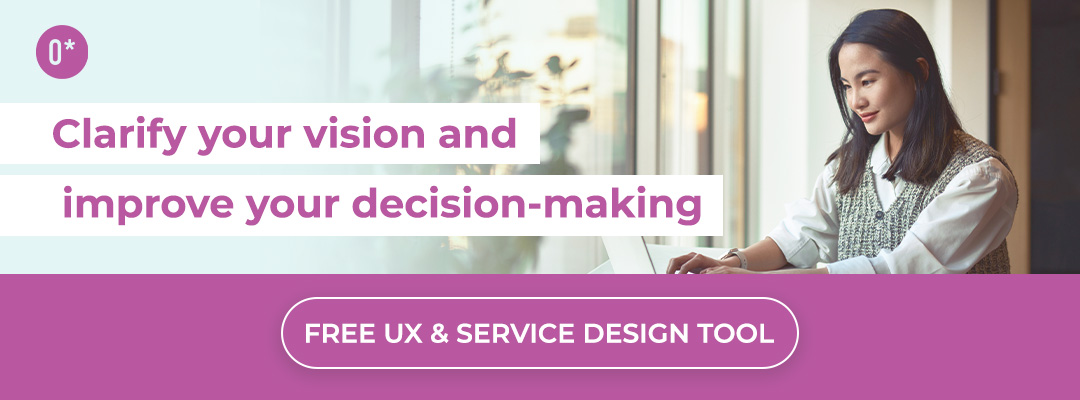Designers and leaders are often required to bring big groups of people together for big conversations. How can we make these conversations productive? How can we facilitate discussions with stakeholders and teams who have differing perspectives and goals? Or when we’re conducting discovery research, how, when, and with whom can we conduct workshops for co-designing solutions or uncovering insights? Not to mention the workshops where we validate ideas and test prototypes. At the end of the day, there are many people and questions to navigate for storytellers and leaders in design.
In this blog post, we highlight the key tips and tricks we’ve learned over the years to make you a better facilitator and ensure your conversations and workshops are valuable, dynamic, and lead to actionable results!
We’ll explore these three central issues:
-
Which type of workshop to conduct, and when
-
How to ensure that your workshops are actionable
-
How to herd cats!? Facilitation techniques that actually work…
Let’s begin by breaking down the different types of workshops involved in design-thinking, human-centered design, and UX projects:
-
Discovery/Kick-Off Workshop: This is generally conducted as part of a project’s initiation. The goal here is to introduce the working teams, establish a collaborative relationship among team members and stakeholders, gather key project drivers and user requirements, and understand what you know and what you don’t yet know.
-
Alignment Workshop: This workshop is necessary when you sense major misalignment among team members and stakeholders on a project. An alignment workshop is great for getting everyone on the same page, airing out “dirty laundry”, and giving all members equal time to express their needs, goals, and desires moving forward. These workshops can be a great opportunity to envision an ideal future state and create guiding principles for your company, product, or service.
-
Co-Design Workshop: Design jams, design-thinking, participatory design, and co-design workshops (whatever you want to call them!) are instrumental once you have already gathered research data and have a good understanding of the problem at hand. With this problem or design challenge well-defined, you can more easily frame your workshop to solve it. In fact, you might facilitate several co-design workshops throughout the lifetime of a project or with different groups. You would present the challenge, and have teams bring their collective knowledge and diverse perspectives together to brainstorm, ideate, be creative, and find solutions.
-
Rapid Prototyping Workshop: This workshop is typically conducted once you are well into the design phase of a project. By this point, you’ve completed the discovery research and created concepts, designs, and rough prototypes. This workshop enables you to test out ideas with users, get rapid feedback, iterate the designs, and test again (and again…) towards a final design. As the name suggests, rapid prototyping workshops are great for gathering feedback and making changes quickly.
-
Other Workshops: Of course, not all workshops will fit into a mould, and at some point you may just need to get a bunch of people together into a room to understand the challenge, prioritize, and make an action plan, journey map a process or workflow, or validate a set of personas.
How to structure a successful workshop in 12 steps
Ready to conduct a workshop? Here’s what you need to do:
-
Know the goal and make a plan. What do you want to accomplish? This might seem obvious, but poorly-crafted conversations and workshops take place all the time. Make sure it is crystal clear why you are getting people together and what you plan to get out of it. Communicate these goals to participants before the day of the workshop so they arrive ready!
-
Set the stage. Take time to think about the overall experience. We really recommend a beautiful, well-lit space (windows are critical) to get the juices flowin’. On desks or tables, you might lay out print-outs of the agenda for reference (or send it out ahead of time to participants to save paper), colourful markers, post-it notes, pipe-cleaners, and any other fun bits you might need. Also, don’t skimp on water, food, and coffee!
-
Craft your day like a story. Each exercise should generally flow into the next, building on the findings from the ones that precedes it. For example, a great opener is the Hopes/Fears exercise, where you ask participants to write down their top 3 fears and top 3 hopes for the initiative on post-it notes (one idea per note), and have them bring their ideas up to the board to explain them. Wrap-up this exercise by thematically grouping the group’s top hopes and fears the group––you will likely identify many similarities and patterns! This is an easy, ice-breaking exercise that immediately builds connections among participants. A follow-up activity might be to prioritize the top fears as a group (using dot voting) for the next exercise. The central idea is to use the outcomes from previous exercises to feed each new exercise. This way, the workshop activities will feel meaningful and purposeful––and your participants will definitely notice!
-
Give each exercise a beginning, middle, and end. In the book Gamestorming, the authors explain that exercises should have an opening (divergent) stage, an exploratory stage, and a closing (converging on ideas) stage. The idea is that participants must continuously feel comfortable and know what is expected of them (via your clear instructions). Give them the opportunity to get their creative juices flowing at the beginning of an exercise, allow time for them to explore their ideas in the middle, and finish the exercise by converging their ideas (crystallizing, doing a quick analysis or summary, picking the top idea, etc.) before moving on to the next exercise.
-
Get crafty! Don’t be afraid to get creative with your exercises. You don’t necessarily need to use predefined workshop exercises you find online or in a book––use those as a base, but make your exercises your own! Think back to your own childhood: did you ever create games or board games with your friends? Did they have rules? How can you create an exercise that will answer a specific question and still be fun and hands-on for participants? Different and unique workshop exercises also ensure that participants are constantly challenged and not bored.
-
Offer step-by-step instructions. This might seem obvious, but there is more to this than meets the eye. When you first explain an exercise, it can be tempting to plop the exercise’s 5 steps into your slideshow, and explain all 5 steps at once to participants. What we find, however, is that people’s attention spans in a workshop setting can be quite short. A participant might begin the first step, and then start asking: “Are we supposed to move on to step 2 right away? I think so, it’s on the slide…” or “What are we supposed to do again for step 3?” Save yourself the trouble, and begin each exercise by only providing one or two steps at a time. Once teams have finished a step, reveal and explain the following step, and so on. Your activities will flow much smoother and participants will never feel lost.
-
Allow time for breaks. People need time to process big ideas, jot down notes, sip coffee, use the restroom, and mingle. Ensure there are clear 10-15 minute breaks time included in your agenda, as well as a 30-60 minute lunch period.
-
Intermingle teams. Enable participants to move around and join new teams, especially if it’s a large group. Midway through the workshop, we recommend switching up groups or seating arrangements, giving everyone space to mingle and exchange ideas. This is also important because team dynamics can sometimes get stale. Mixing up teams is a great way to keep everyone participating with high energy.
-
Create an idea “parking lot”. In the form of flip-board chart paper, or a large sticky note pad, ensure you have a “parking lot” for stray ideas that are outside the scope of discussion, but that you don’t want to lose sight of entirely. Your goal is for participants to feel heard, so have them jot down good but off-topic ideas in the parking lot. Side note: A great way to quell an overactive talker is to say, “why don’t we put that idea in the parking lot?”…and move on.
-
Grab their attention. In a big room with lots of voices, you need to find ways to keep participants on track with a timer, chime, or other signal. When people are enjoying themselves, it can be tricky as the facilitator to pull their attention back for the next exercise. Give participants a warning when time is almost up on a specific exercise. Use a large timer that’s visible to all, or use a chime or gong sound. We have even resorted to flickering the lights to grab attention, but a clearer signal or sound is usually best.
-
Be a fierce timekeeper. To move through your carefully planned exercises, watch the time, don’t be afraid to cut off exercises or (eep!) chatty participants, and generally stay on track. This is often tough to do. It can also mean canceling one exercise in favour of giving participants more time if ideas and discussion are really flowing. Be flexible––but don’t be afraid to put your foot down and keep the day moving. Most importantly: end the workshop on time. No one likes to stay late after a long day of workshopping. Respect people’s time.
-
Wrap-up. No matter where you land at the end of the day, you need to succinctly wrap things up for participants. Summarize what you accomplished, grab a flip board and marker, and ask the group these four big questions:
-
What are some possible next steps?
-
What is the biggest takeaway from today?
-
If you could choose one item from today to move forward with and implement, what would it be?
-
What did we miss or not have time to cover?
-
View this post on Instagram
Click through for some workshop inspiration…
Finally, once you’ve answered these questions, each participant should walk out the door knowing the next steps. Will you be sending a follow-up email to everyone with results from that day? Are you creating a workshop insights report or action plan for the entire group? Be sure to clearly communicate these conclusions and next-steps in your wrap-up.
At Outwitly, we can facilitate a diverse range of workshops for your team. Find out more about our business transformation, journey mapping, and training workshops!
Workshop tools we like…
-
MURAL for remote workshops/brainstorming
-
Large sticky post-it note pads from Staples
-
An online workshop timer, BigTimer
-
An individual table timer
-
Chimes for grabbing a group’s attention
Resources we like…
-
Gamestorming: A Playbook for Innovators, Rulebreakers, and Changemakers by James Macanufo & Sunni Brown, full of endless workshop activity ideas
-
Moments of Impact: How to Design Strategic Conversations that Accelerate Change, a super useful book by Chris Ertel & Lisa Kay Solomon





